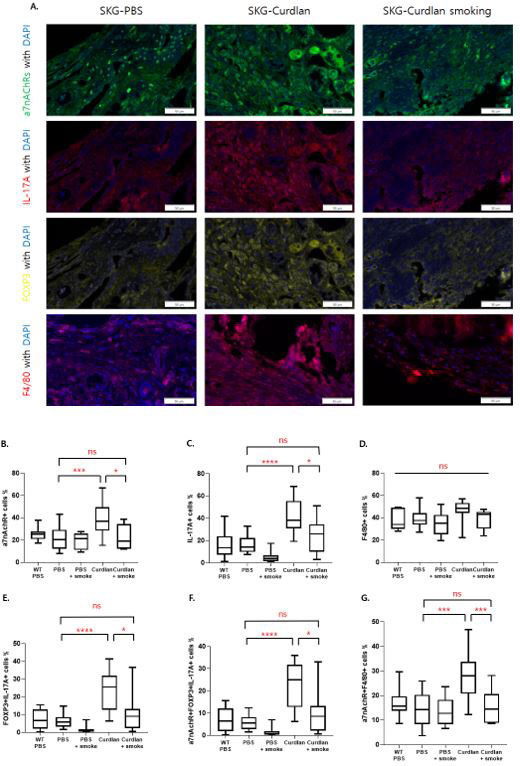Session Information
Date: Sunday, November 13, 2022
Title: Spondyloarthritis Including PsA – Diagnosis, Manifestations, and Outcomes Poster II
Session Type: Poster Session B
Session Time: 9:00AM-10:30AM
Background/Purpose: Alpha7 nicotinic acetylcholine receptor (α7nAChR), a member of AChR expressed in various immune cells and synoviocytes, has an important role in the anti-inflammatory pathway by downregulating proinflammatory cytokines. There has been growing evidence that nicotine has an anti-inflammatory property in autoimmune arthritis by activating α7nAChR on TH17 cells. However, not much is known about the effect of α7nAChR stimulation in spondyloarthropathy (SpA). We aimed to investigate the effect of cotinine, the metabolites of nicotine with long half-lives, on peripheral arthritis and spinal ankylosis in curdlan-administered SKG mice, murine models of spondyloarthropathy.
Methods: 8-week-old SKG mice were divided into the curdlan group (with or without smoking) and the PBS group (with or without smoking). In the curdlan group, curdlan was injected two times at 2-week intervals. Mice with smoking in both groups inhaled the cigarette smoke (4 cigarettes per 15 min and rest 10 min repeat) five days a week for 20-weeks since the first curdlan injection. The serum concentration of cotinine was measured at 16-week post-curdlan injection. The clinical scores for peripheral arthritis were evaluated every week. At 23 weeks, all mice were sacrificed, and splenocytes were examined for auto-reactive T cells population by flow cytometry. Immunohistochemical stains were performed for the auto-reactive T cells population. All α7nAChR expression in TH17 cells was detected using flow cytometry. To identify the presence of osteoblastic activity in the spine, imaging was performed using the fluorescent in vivo bisphosphonate agent at 21-week post-curdlan injection.
Results: At 23-week post-curdlan injection, increased α7nAChRs+ and α7nAChRs+F4/80+ cells were detected in synovia of curdlan-administered SKG mice. Metabolomics analysis at 16-week post-curdlan injection, level of cotinine was increased in smoked mice. Peripheral arthritis score was better in the curdlan group with smoking than the curdlan group without smoking. Similarly, synovial inflammation was scored lower in curdlan-administered SKG mice with smoking than those without smoking on the histologic examination. However, osteoblastic activities on the spine were not different between groups measured by fluorescence of hydroxyapatite. In flow cytometry analysis, TH17 and Treg populations were not different between groups, however, the IL-17A+ Treg population was decreased in curdlan-administered SKG mice with smoking. Furthermore, the percent of IL-17A+ cells, FOXP3+ cells, and IL-17A+FOXP3+ cells was decreased in synovia of curdlan-administered SKG mice with smoking compared with those without smoking.
Conclusion: This is the first experiment suggesting that cigarette smoking ameliorates peripheral arthritis in curdlan-administered SKG mice, with abundant α7nAChRs+ cells present in the synovia. Therefore, cotinine may play a potential role in alleviating peripheral arthritis in mice.
To cite this abstract in AMA style:
Kim Y, Lee E, Lee J, Ahn S, Oh J, Hong S, Lee C, Yoo B, Kim Y. Anti-arthritogenic Effect of Smoking in Curdlan-Administered SKG Mice [abstract]. Arthritis Rheumatol. 2022; 74 (suppl 9). https://acrabstracts.org/abstract/anti-arthritogenic-effect-of-smoking-in-curdlan-administered-skg-mice/. Accessed .« Back to ACR Convergence 2022
ACR Meeting Abstracts - https://acrabstracts.org/abstract/anti-arthritogenic-effect-of-smoking-in-curdlan-administered-skg-mice/



